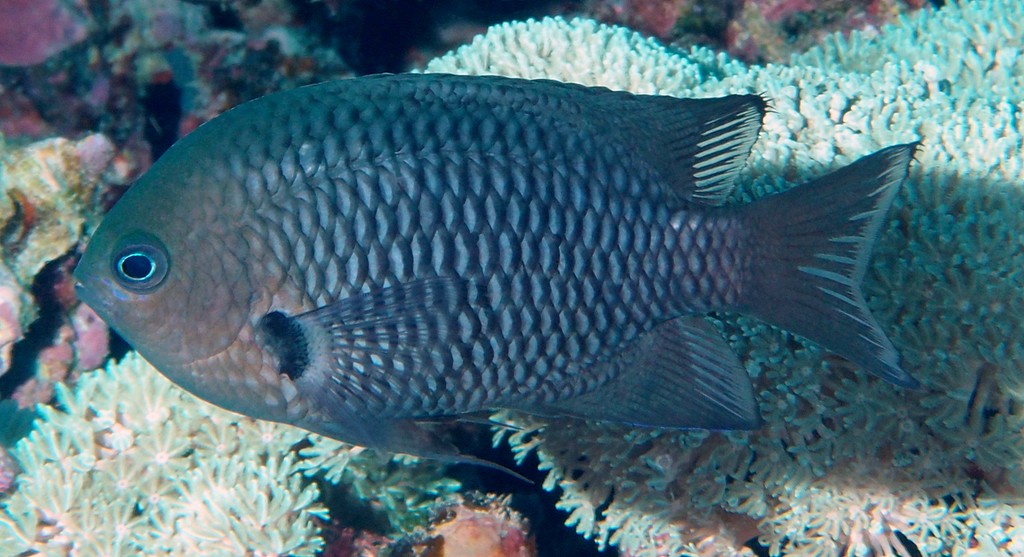POMACENTRUS NIGRIRADIATUS - (ALLEN, ERDMANN & PERTIWI, 2017)
Actinopterygii (Gigaclass) > Actinopteri (Class) > Teleostei (Subclass) > Blenniiformes (Order) > Pomacentridae (Family) > Pomacentrinae (Subfamily) > Pomacentrus (Genus)
Poisson demoiselle à raies noires, Blackray Damselfish,
Description
Dorsal spines (total): 13; Dorsal soft rays (total): 14-15; Anal spines: 2; Anal soft rays: 14-15; Pectoral fin rays: 17-18 (rarely: 17); Tubed lateral line scales: 17-19 (rarely: 19); Total gill rakers on first arch: 22-24 (rarely: 22); Body depth: 1.9-2.2 in SL; A patch of scales usually present on preorbital and a single row of scales on suborbital, continuing around posterior margin of eye; Dorsal profile of head evenly rounded from dorsal fin origin to snout; Snout shorter than orbit. Max. length: 10.0 cm TL. Depth range: 8 - 20 m.
Color
Juvenile and subadult similar as adult, but dark scale margins and dark fin rays of median fins less prominent; Also with bright blue outer margins on dorsal and anal fins, as well as on anterior edge of pelvic fins, and blue stripe on dorsal scleral surface of each eye.
Body of adult overall gray to gray brown with thick black or dark-brown scale margins producing a network pattern; Head dark gray to brownish, sometimes with small, scattered blue spots; Blue stripes sometimes on side of snout and immediately below lower margin of eye; Eye with narrow white ring around pupil, dorsal scleral surface either uniform grayish or with a few blue markings; Dorsal and anal fins mainly dark gray with black spine tips and a thin blue outer margin, except posterior edge of fin broadly translucent with conspicuous contrasting blackish fin rays; Caudal fin mainly dark gray, except broadly translucent posteriorly with similarly conspicuous contrasting dark-gray to blackish fin rays, tip of lobes and posterior margin finely blackish; Pelvic fins dark gray to blackish; Pectoral fins translucent with dusky gray rays; A black spot covering entire pectoral-fin base (including axil side), bordered posteriorly with pale gray halo; Inner side of pectoral fin axil tannish to pale gray.
Etymology
Pomacentrus: from Greek, poma, -atos = cover, operculum + from Greek, kentron = something with a sharp point: point, spike, spur, sting, quill, thorn. Referring to serrations and prickles along margins of opercular bones of Pomacentrus pavo.
nigriradiatus: from Latin, niger = shinning black + from Latin, radiatus = radiated, rayed. The new species is named nigriradiatus with reference to the diagnostic dark rays on the posterior sections of the median fins.
Original description: Pomacentrus nigriradiatus Allen, Erdmann & Pertiwi, 2017 - Type locality: Samoa, Upolu Island, off Lotofaga, 14°01.034’ S, 171°50.644’ W, 12–15 m, spear, M.V. Erdmann, 16 August 2015.
Distribution
Southwestern Pacific: New Caledonia, east to American Samoa.
Similar species
Pomacentrus imitator (Whitley, 1964) - Reported from New Caledonia. It's have a bluish or violet head and body and a bright yellow tail, with a sharply contrasting yellow iris and a yellow patch on the pectoral fin axil.
Last update: 10, July 2024
Poisson demoiselle à raies noires, Blackray Damselfish,
Description
Dorsal spines (total): 13; Dorsal soft rays (total): 14-15; Anal spines: 2; Anal soft rays: 14-15; Pectoral fin rays: 17-18 (rarely: 17); Tubed lateral line scales: 17-19 (rarely: 19); Total gill rakers on first arch: 22-24 (rarely: 22); Body depth: 1.9-2.2 in SL; A patch of scales usually present on preorbital and a single row of scales on suborbital, continuing around posterior margin of eye; Dorsal profile of head evenly rounded from dorsal fin origin to snout; Snout shorter than orbit. Max. length: 10.0 cm TL. Depth range: 8 - 20 m.
Color
Juvenile and subadult similar as adult, but dark scale margins and dark fin rays of median fins less prominent; Also with bright blue outer margins on dorsal and anal fins, as well as on anterior edge of pelvic fins, and blue stripe on dorsal scleral surface of each eye.
Body of adult overall gray to gray brown with thick black or dark-brown scale margins producing a network pattern; Head dark gray to brownish, sometimes with small, scattered blue spots; Blue stripes sometimes on side of snout and immediately below lower margin of eye; Eye with narrow white ring around pupil, dorsal scleral surface either uniform grayish or with a few blue markings; Dorsal and anal fins mainly dark gray with black spine tips and a thin blue outer margin, except posterior edge of fin broadly translucent with conspicuous contrasting blackish fin rays; Caudal fin mainly dark gray, except broadly translucent posteriorly with similarly conspicuous contrasting dark-gray to blackish fin rays, tip of lobes and posterior margin finely blackish; Pelvic fins dark gray to blackish; Pectoral fins translucent with dusky gray rays; A black spot covering entire pectoral-fin base (including axil side), bordered posteriorly with pale gray halo; Inner side of pectoral fin axil tannish to pale gray.
Etymology
Pomacentrus: from Greek, poma, -atos = cover, operculum + from Greek, kentron = something with a sharp point: point, spike, spur, sting, quill, thorn. Referring to serrations and prickles along margins of opercular bones of Pomacentrus pavo.
nigriradiatus: from Latin, niger = shinning black + from Latin, radiatus = radiated, rayed. The new species is named nigriradiatus with reference to the diagnostic dark rays on the posterior sections of the median fins.
Original description: Pomacentrus nigriradiatus Allen, Erdmann & Pertiwi, 2017 - Type locality: Samoa, Upolu Island, off Lotofaga, 14°01.034’ S, 171°50.644’ W, 12–15 m, spear, M.V. Erdmann, 16 August 2015.
Distribution
Southwestern Pacific: New Caledonia, east to American Samoa.
Similar species
Pomacentrus imitator (Whitley, 1964) - Reported from New Caledonia. It's have a bluish or violet head and body and a bright yellow tail, with a sharply contrasting yellow iris and a yellow patch on the pectoral fin axil.
Last update: 10, July 2024
